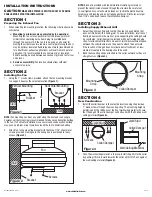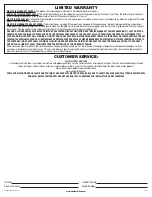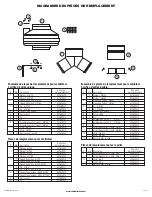
SECTION 5
Existing Construction
1. Place the collar/damper in the selected location and trace a circle
onto the surface. From the interior side of the room, cut through the
surface. Please note: Take care not to damage the ceiling and make a
smooth cut
(Figure 6).
2. Position the collar/damper in the previously cut hole so that it is flush
with the finished ceiling and secure to the joist/stud using the provided
1” wood screws through the mounting strap
(Figure 4).
3. Install the grill into the collar by pushing it firmly inward towards the
collar until it fits flush against the wall/ceiling material
(Figure 5).
SECTION 6
Ducting
CAUTION:
ALL DUCTING MUST COMPLY WITH LOCAL AND
NATIONAL BUILDING CODES.
NOTE:
Insulated ducting is required for bathroom exhaust applications, where
ducting passes through unconditioned space or where noise is a factor.
Failure to use insulation could result in excessive condensation buildup within
the duct, and undesirable sound levels within the room. Duct runs should
have as few bends as possible.
NOTE:
Flexible insulated ducting may be used where allowed by local
code. For the quietest possible installations, it is recommended a minimum
of 8’ of insulated flexduct be used between any exhaust grill and fan.
When using flexible type duct work, duct should be stretched as tight and
straight as possible. Failure to do so could result in dramatic loss of system
performance. Flexible duct should be connected to the fan with screw clamps
or duct tape. All connections should be as airtight as possible to maximize
system performance.
1. Connect one end of the ducting (not included) to the room level collar/
damper and the other end to the “Y” transition. Secure both ends in place
using tape or a screw clamp to create as air tight a seal as possible.
Repeat this step for the other room level grill housing
(Figure 7).
www.airkinglimited.com
A210952017 Rev. B 8-12
3 of 12
NOTE:
Units that include only one collar do not utilize the “Y” transition.
Follow the same instructions as in step 1, except connect the one end of
the ducting directly to the fan.
2. Connect one end of the ducting to the top of the “Y” transition and the
other end to the intake of the fan
(Figure 7).
3. Connect one end of the ducting to the exhaust of the fan and the other
end to a wall or ceiling cap
(Figure 7).
Always duct the fan to the
outside through a wall or roof cap.
NOTE:
When using insulated flex duct, it is recommended that the inner vinyl
core be screw clamped or taped to the inlet and outlet and that the vapor
barrier surrounding the insulation be taped to the fan housing.
NOTE:
When attaching flex duct to the collar/damper combination and an
immediate elbow is necessary, be certain that the elbow is installed with a
“soft” bend to allow damper blades to operate properly.
SECTION 7
Installing Optional Balancing Damper
Some kits include an optional balancing damper to allow for adjustment of
the system. The damper may be used where the grills will be connected
using branches of unequal length or where the flow will need to be balanced
for any reason. To Install the optional damper:
1. The damper must be installed on the branch with the least restriction.
This is generally the duct that is shortest or has the fewest bends.
2. Drill a 5/16” hole approximately 1-1/2” from the edge on the flat side
of the “Y” transition.
3. Insert the shaft of the damper into the hole drilled in step 2. Place the
washer, handle, then wing nut onto the shaft
(Figure 8).
Figure 5
Collar/Damper
Grill
Figure 6
Exhaust to
Wall/Roof Cap
Figure 7
Fan
“Y” Transition
Ducting
Collar/Damper
Wing Nut
Washer
Hole
Handle
Shaft
Damper
“Y” Transition
Figure 8






























